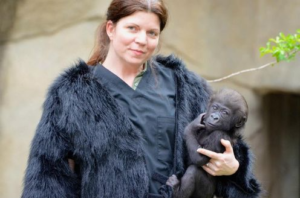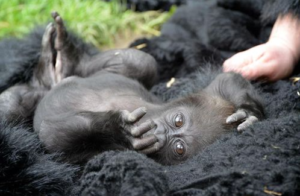The Cincinnati Zoo’s 3-month-old Western Lowland Gorilla named Gladys made her public debut in the outdoor yard on April 30. Over the next month, Gladys will be doing this with her human surrogates as part of Phase III of her “gorillification.” The surrogates will allow her to explore all areas of the outdoor yard, climb trees and duck into caves. Besides being enriching, this process will ensure Gladys is familiar with the yard and comfortable when she goes out again with her gorilla surrogate in the future.
Gladys was born at the Gladys Porter Zoo on January 29. The mother, 14 -year-old Kiazi, didn’t respond well to the infant and ultimately rejected her. This behavior, which occasionally happens in first-time mothers, resulted in keepers from the Gladys Porter Zoo stepping in to hand-rear the infant until they had a plan in place. Unfortunately, all of the viable surrogates there already had young gorillas, so they began to look elsewhere. After countless phone calls with the Association of Zoos & Aquariums (AZA) Ape Taxon Advisory Group (TAG) Maternal Management Committee and the Western Lowland Gorilla Species Survival Plan (SSP) Committee, the Cincinnati Zoo was determined to be the best home for the baby. Gladys is currently being hand raised by a group of approximately 10 human surrogates, until she can transition to a gorilla surrogate in the coming months.



Western Lowland Gorillas are Critically Endangered, with less than 175,000 individuals in the wild. Due primarily to habitat destruction caused by logging, mineral mining and agricultural expansion, wild gorilla numbers continue to shrink. The bushmeat trade – the killing of wild animals to be used as human food – is also a major threat to the Western Lowland Gorilla population throughout the Central African rainforests. Over 1,000 gorillas are illegally poached for the bushmeat trade each year.
See more picturess of Gladys and her surrogates on their first outing below the fold:
